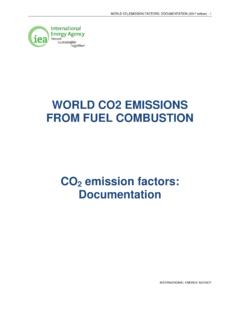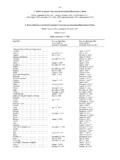Transcription of Challenges for Regional Integration in Sub-Saharan Africa ...
1 11. Challenges for Regional Integration in Sub-Saharan Africa : Macroeconomic convergence and monetary coordination Mothae Maruping T he majority of Sub-Saharan African countries are members of one or more Regional or sub- Regional arrangements that seek to pro- mote economic coordination , cooperation or Integration among the member countries concerned. The various African Regional economic blocs, and indeed the individual countries that comprise their member- ship, are at varying stages of development and implementation of their Regional arrangements. The blocs' scope covers various socio-economic, developmental and political considerations, including the promotion of intra- Regional trade, socio-economic policy coordination , and manage- ment or development of shared physical infrastructure and the environ- ment.
2 Some of the African Regional arrangements also cover issues of common interest in the areas of public governance, defense and security, among other socio-economic and political dimensions (see Box 2 below). Some of the many African sub- Regional arrangements have a long history of existence, dating back to the pre-independence era, which has been punctuated by occasional stagnations or reversals in a few cases, and only modest achievements at best in others. Some African countries have only recently rekindled their interest in economic Integration , but for different reasons from the initial decolonisation agenda and the desire to overcome the colonially imposed artificial boundaries. They have been inspired by the success of Integration efforts in Europe and the Americas. They also need post-independence economic Integration to 129.
3 From: Africa in the World Economy - The National, Regional and International Challenges Fondad, The Hague, December 2005, 130 Challenges for Regional Integration in Sub-Saharan Africa gain bargaining power and survive economically against the threat of marginalisation in the globalisation process. Countries in the region have also pursued Regional Integration in the context of South-South cooperation, which was necessitated partly by the declining terms of trade and disappointment with the rejection of the New International Economic Order (NIEO) proposal in the 1970-80s. However, in order to translate the dreams about economic Integration into reality, Africa 's perceptions, approach and pace in this area will need to shift towards more pragmatism and meticulous implementation of the agreed agenda.
4 It should be tackled in a way that can effectively address the Challenges encountered in the process of Regional Integration . In this context, this chapter focuses on the achievements, lessons, Challenges and the way forward for one of the key components of Regional Integration process, which is macroeconomic convergence . The chapter looks at the case of Eastern and Southern African countries. The two economic blocs in question are the East African Community (EAC), and Southern African Development Community (SADC). The latter also encompasses the long-established but smaller sub-grouping of the Southern African Customs Union (SACU), along with its Common monetary Area (CMA) of all but one SACU member state. EAC and SADC intersect with COMESA. 1 The Meaning of Regional Economic Integration Goals of Economic Integration The ultimate goal of Regional Integration is to merge some or all aspects of the economies concerned.
5 This usually evolves from simple cooperation on and coordination of mutually agreed aspects amongst a given number of countries to full Integration or merger of the economies in question. Objectives of Economic Integration The history of Regional Integration in Africa shows that the reasons or objectives for integrating have been evolving over time. These have shifted from the initial focus on the political decolonisation of Africa to the current emphasis on socio-economic Integration in the post- independence era for stronger bargaining base in global fora and for mutual benefit in the form of accelerated growth and development. From: Africa in the World Economy - The National, Regional and International Challenges Fondad, The Hague, December 2005, Mothae Maruping 131. Box 1 The Stages, Pros and Cons of Regional Economic Integration By definition, Regional Integration entails the coming together of two or more states, normally through reciprocal preferential agreements, based on one of more of the following successively more integrating cooperation arrangements: Preferential Trade Area (PTA) or Agreement, where member states charge lower tariffs to imports produced by fellow member countries than they do for non-members.
6 Free Trade Area (FTA), a PTA without any tariffs on fellow members' goods;. Customs Union, an FTA using the same or common tariffs on imports from non-members;. Common Market, a customs union with free movement of the factors of production;. Economic Community, a single-currency common market or monetary union in which fiscal and monetary policies are unified. If political sovereignty is given up, an economic community becomes a federation or political union with common legislation and political structures. Pros and Cons of Integration Regional Integration can foster competition, subsidiarity, access to wider market (via trade), larger and diversified investment and production, socio-economic and political stability and bargaining power for the countries involved. It can be multi-dimensional to cover the movement of goods and services ( trade), capital and labour, socio-economic policy coordination and harmonisation, infrastructure development, environmental management, and reforms in other public goods such as governance, peace, defense and security.
7 However, Integration can be complicated by perceived or real gains or losses among the members that may lead to disputes and a sense of loss of national sovereignty. For success, Integration thus requires strong commitment in implementing the agreed arrange- ments, fair mechanisms to arbitrate disputes and equitable distri- bution of the gains and costs of Integration . From: Africa in the World Economy - The National, Regional and International Challenges Fondad, The Hague, December 2005, 132 Challenges for Regional Integration in Sub-Saharan Africa The basic objectives that have underpinned the pursuit of Regional Integration are to merge economies, integrate them, and, as a deri- vative, thus form a monetary union. This requires a harmonisation of economic policies, to pave way for merger, hence convergence .
8 Other derivatives of Integration objectives are the enlargement and di- versification of market size, and tapping of related opportunities and the promotion of intra- Regional trade and free movement of the factors of production, which also results in stronger member states' bargaining posi- tion in relation to other Regional and international blocs and the fostering of socio-economic progress, political stability, as well as peace and security. The varying emphasis placed on the objectives for the different African Regional blocs is influenced by the specific stage of development of the Integration process, including the expected benefits and costs (see Box 1). Given the fragmented and small sizes of its low-income economies, Africa needs to competitively participate in multilateralism from a regionalised standpoint, to negotiate more effectively for international market access and ward off marginalisation and unfair competition in the global arena.
9 Conditions for Effective convergence Much of African Regional Integration history shows that they initially arose from political rather than economic or developmental agendas, but more recently they have been re-launched with an economic focus. Some Regional economic groupings have been shallow arrangements that have tended to skip the necessary sequencing (progression through the development stages). It is essential that the following conditions are ful- filled for successful macroeconomic convergence : efficient and non-distortionary markets for products and factors of production, including freer movement of capital notably labour;. effective compensatory financing arrangements to make the domestic costs of adjustment affordable, and equitably share the costs and benefits of Integration , and fully incorporate the effects of exogenous shocks such as adverse weather, terms of trade, disease, and external financing shocks including debt relief.
10 Proper timing and sequencing as well as consensus-based choice of a convergence anchor (whether rigid or flexible benchmarks and criteria);. enabling policies that reduce risks;. development and retention of expertise;. focus on smaller sub-groupings for greater success, with provision for variable geometry and variable/multi-speed arrangements. From: Africa in the World Economy - The National, Regional and International Challenges Fondad, The Hague, December 2005, Mothae Maruping 133. Box 2 Overview of the Developments in African Regional Integration Blocs Africa is not alone in aspiring for Regional Integration . With increasing globalisation and the advent of the World Trade Organization (WTO), other parts of the world have embraced the ideal. Among others, these include: The European Union, in which some members have opted for a single currency, a central bank and for all members free movement of factors of production.







